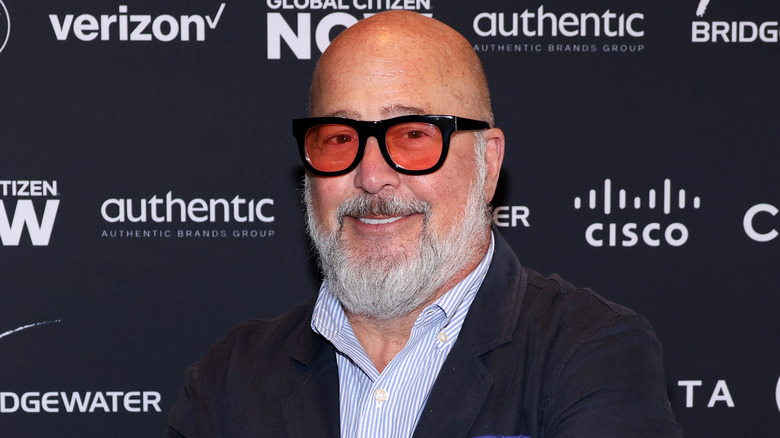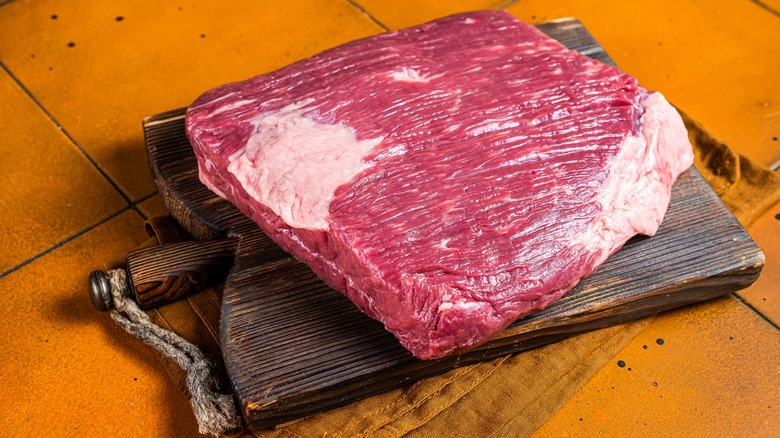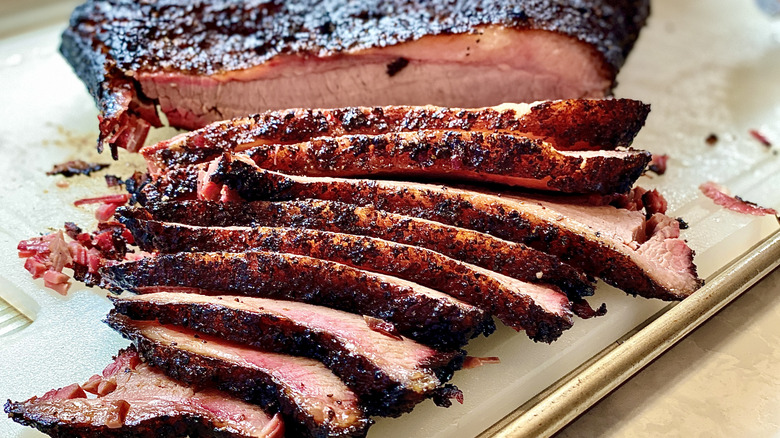Why Andrew Zimmern Always Chooses A Small Brisket When Grilling
Whether you're cooking it low and slow in the oven or making barbecue brisket with cowboy butter, a tasty beef brisket makes a great choice for feeding a crowd. Often much cheaper than more premium cuts, it tends to offer a good value for any occasion, so to get even more for your money, surely bigger is always better — right? Well, it's not quite that simple, explains pro chef Andrew Zimmern.
Zimmern's brisket recipe has been passed down through generations from his grandmother. Every time he makes it, he avoids really huge cuts, instead opting for something smaller, around the six to nine pound mark. The reason comes down to how evenly the meat cooks, as it's much easier to achieve and gauge the perfect doneness on a smaller piece of beef. Brisket is full of collagen and connective tissue that must fully break down to make the meat tender, which makes even cooking super important. There's an advantage when it comes to timing, too, since smaller cuts cook faster than very large ones.
Brisket can be a tricky cut to get just right, and can easily end up tough and chewy if you're not careful. No matter which cooking method you choose, it's wise to follow Zimmern's example and avoid oversized hunks of meat, if you want the best results with less stress.
Choose smaller briskets for more even cooking
Brisket is made up of the flat cut (also known as the first cut) and the point cut, sometimes referred to as the second cut or deckle. While each section can be prepared in different ways — the leaner flat tends to work better for braising, while the fattier deckle is great on the grill — Andrew Zimmern prefers to use the whole thing, as it's more forgiving. On its own, the flat cut easily dries out, so the fat cap on the point can help it out.
Also known as the packer cut, a whole piece also happens to be the best brisket cut for barbecue, according to Aaron Franklin. While whole briskets can be huge, weighing up to 15 pounds, Zimmern always skips out on these. A common complaint about brisket is uneven cooking, with some parts becoming hard and dry. Undercooked brisket is tough and chewy, too, so you don't want a huge cut that winds up undercooked in the center and burnt on the outside.
If you've got an especially large crowd to feed, you may still be thinking it's better to go bigger. But Zimmern's advice is to cook two smaller briskets if you need to increase your output. And if you end up with leftovers, there are plenty of delicious ways to use them. Try giving breakfast sandwiches a smoky twist with brisket, use it in a chili, or as a tasty topping when making nachos.
More tips for cooking small brisket to keep it tender
Brisket requires low and slow cooking so that it stays juicy, and while a smaller brisket will cook more evenly overall, it's especially important to keep the heat low and ensure doesn't burn. If you're smoking the meat, it's best to go for a lower temperature of around 225 to 250 degrees Fahrenheit. Just bear in mind that it's a long process: A nine pound piece of meat could take up to 14 hours. While this is quite a while, imagine how long a 15-pounder might take.
If you prefer braised brisket, it will take around six to seven hours at 300 degrees Fahrenheit to cook a nine-pound cut, and slightly longer if you want to use a more gentle 275 degrees F. Make sure the braised meat reaches a final temperature of 180 degrees Fahrenheit when you stick a thermometer in the thickest part.
One key advantage of braising brisket is that you can cook it the day before you serve it, or even up to four days in advance. Either keep it in the refrigerator whole, or slice it in a tray and cover it in the cooking liquid to keep it moist. Then, just gently reheat it when you're ready. While you can also smoke the meat up to three days in advance, it will tend to be most delicious when freshly-cooked on the grill.



